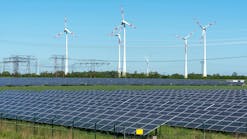Solar energy jobs were up in 47 states and increased 9% nationwide from 2020 to 2021 to a total of 255,037 solar workers. These findings are in the annual National Solar Jobs Census released by the Interstate Renewable Energy Council (IREC), an independent national nonprofit organization.
This job growth took place in a year of record solar installations driven by increased demand for renewable energy among residential customers, municipalities, businesses, and electric utilities. Overall, the solar industry added 21,563 jobs in 2021, with more than two-thirds of these new jobs (14,350) at installation and project development firms.
“America’s solar industry came back strong from the pandemic to expand the clean energy workforce across all regions of the country,” said Larry Sherwood, president and CEO at IREC. “The future remains uncertain in light of the supply chain disruptions, trade issues, and stalled federal policy in the first part of 2022. There is potential for unprecedented job growth in the coming years if federal, state, and local leaders take action to expand clean energy use and address climate change.”
Over the past decade, U.S. solar employment has more than doubled from 105,145 jobs in 2011 to 255,037 jobs in 2021. The most significant growth has taken place in the installation and project development sector, where employment more than tripled since 2011 to reach 168,960 jobs in 2021.
At the state level, California continues to lead in the total number of solar jobs with 75,712 jobs as of 2021, followed by Florida (11,761 jobs), Massachusetts (10,548 jobs), New York (10,524 jobs), and Texas (10,346 jobs). These are followed by Arizona, Colorado, Nevada, and Ohio, each with 7000 to 9000 jobs.
California also led for the number of jobs added in 2021 (7035 new jobs), followed by Massachusetts (+1,053 jobs), Nevada (+1,019 jobs), and Arizona (+932 jobs). Other strong growth states were Ohio, North Carolina, New Jersey, and Georgia, each with 800–900 new jobs. A complete table of solar jobs by state and job growth from 2020 is available at https://irecusa.org/programs/solar-jobs-census/.
"Solar energy is an economic growth engine, creating new jobs while it helps us confront the climate crisis,” said Dan Reicher, senior Scholar, Stanford Woods Institute and former U.S. assistant secretary of energy. “There is vast and untapped potential to expand solar installations and related jobs across the United States, in an environmentally sustainable manner, as we help businesses and families access this renewable energy source.”
The solar industry still has more work to do to meet its goals for diversity, equity, and inclusion and extend the benefits of the clean energy economy to underrepresented groups. The report found that women made up just under 30% of the solar workforce in 2021, while Black employees made up 8% of the workforce, Latino or Hispanic workers made up 20%, and Asian workers made up 9%. Fewer than one-third of solar firms reported strategies to increase female, ethnic or racial minority, or LGBTQ+ hires.
The solar industry can offer a path to advancement and a family-sustaining career, including for those without a two- or four-year college degree. Less than one-third of entry-level solar jobs (31%) require a bachelor’s degree, while 65% of firms provide on-the-job training. In a year with a tight labor market, 89% of firms reported difficulty finding qualified applicants, including 35% that said it was “very difficult.”
“These 2021 findings highlight that we can create family-sustaining jobs at the same time that we reduce carbon emissions,” said Tom Starrs, vice-president, Government and Public Affairs at EDP Renewables. “They also highlight the critical importance of supportive policies to unlock the full potential of the solar industry to drive employment, foster local energy resilience, and confront climate change.”
This report analyzes data from the U.S. Department of Energy’s U.S. Energy and Employment Report 2022 and a supplemental follow-up survey of solar establishments. Both surveys were administered by BW Research Partnership. The National Solar Jobs Census defines a solar employee as someone who spends 50% or more of their time on solar-related work.
The National Solar Jobs Census was first published in 2010 by The Solar Foundation, which merged with IREC in 2021. The full report and related data can be downloaded at https://irecusa.org/programs/solar-jobs-census/.


